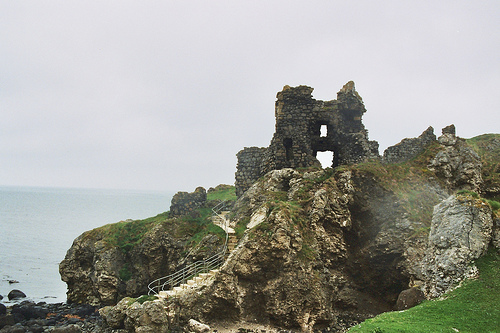|
|
|
Dunaneeny Castle.County Antrim.From "Sketches of olden days in Northern Ireland" by Rev. Canon Forde. |
| |
Dunaneeny
Castle. |
||
| This
fortress stands on the Tradition says it was built by the O'Carrols, an old family who resided here many centuries ago. Later, the chieftains of the MacDonnells made this one of their principal strongholds, and from it they could watch their galleys gliding into Port Brittas almost at its base. The castle is notable for being the birthplace of the second Sorley Boy MacDonnell, who was born here in 1505. It was from here, at the head of his kerns and gallowglasses, he led them from victory to victory, till he became master of the whole of the Route. It was here, too, he died, and from here he was carried to his resting-place, the procession making its way through Ballycastle to the Abbey of Bun-na-mairgie, where they laid their gallant chief in a soldier's grave.The ruins of this ancient church and friary are only a few minutes' walk from Ballycastle. The friary is said to have been built by the MacQuillins, and to have been enlarged by the MacDonnells. Formerly a river ran close to the abbey, but its course was diverted in 1738 by Mr. Boyd, in order that it might help to deepen the inner dock.. The church and friary were built of Ballycastle sandstone, filled in with small stones. From the fourteenth or fifteenth century it was occupied by Franciscan friars of the third order. The church suffered considerable damage on 4th January, 1584, when the English of the Pale, under Sir John Perrott, marched to Bun-na-mairgie, where, leaving his cavalry in charge of Sir William Stanley in and around the church, he placed his infantry in the Fort of Ballycastle. Sorley Boy was on his way home with several galleys full of Scots, but his followers, anticipating his arrival, attacked the English troops at Bun-na-mairgie at one o'clock in the morning, and set fire to the roof of the church, which was thatched. The church was full of horses. A severe battle ensued, in which Sir William Stanley was wounded, and Sir John Perrott was forced to withdraw his troops, but took with him St. Columba's cross from the church, which he sent to Sir Francis Walshingham, describing it as Sorley Boy's cross, with a request it should be given to Lady Walshingham. The church was subsequently restored and the friary again reoccupied. The churchyard of Bun-na-mairgie was the burial-place of the MacDonnells. The place, says Rev. George Hill, heaves with the MacDonnell dust. There were those who fell when James MacDonnell slaughtered the MacQuillins in Glenshesc at the battle of Aura. There were those who fell when Shane O'Neill overthrew Sorley MacDonnell and his brother James in 1665 at Glenshesc or Glentow. There were, too, those who fell around Bun-na-mairgie in 1584 when Sorley Boy and his followers repulsed Sir John Perrott and his followers. It is said that during this period heaps of bodies were carried there and left unburied for weeks until an opportunity came. |
||
|
Kinbane
Castle from "Sketches of olden days in Northern Ireland"
by Rev Forde. |
|



 summit
of a bold promontory that rises to a great height above the sea. Dunaneeny
means " the fort of the assembly or fair." The area on which
the castle stood is a smoothlevel, measuring from east to west 60 yards,
and from north to south 35 yards. It was surrounded by the sea on all
sides except the south, where it was protected by a moat extending from
east to west 80 yards, cut chiefly through the solid rock. The highest
part of the wall now remaining is only 12 1/2 feet, and every vestige
of the castle which stood within the fortified area has disappeared.
summit
of a bold promontory that rises to a great height above the sea. Dunaneeny
means " the fort of the assembly or fair." The area on which
the castle stood is a smoothlevel, measuring from east to west 60 yards,
and from north to south 35 yards. It was surrounded by the sea on all
sides except the south, where it was protected by a moat extending from
east to west 80 yards, cut chiefly through the solid rock. The highest
part of the wall now remaining is only 12 1/2 feet, and every vestige
of the castle which stood within the fortified area has disappeared.